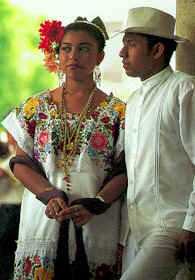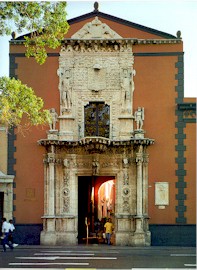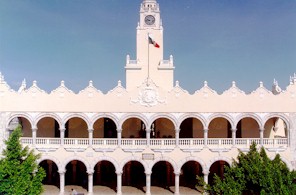THE FIRST AMERICAN CAPITAL OF CULTURE
Merida - T'Hó (Yucatan, Mexico ) - A landscape of identity.
For the first time in history, a city in one of the 35 countries in America has received the annual designation of American Capital of Culture, an initiative that counts with the full support and collaboration of the Organization of the American States. This designation is to be a tool for the greater understanding and cohesion of the American People and the projection of the American culture to the rest of the world. Merida will hold the designation of American Capital of Culture for the full year 2000.
When low-level flying over the flatness of the Yucatan Peninsula, in tropical south-east Mexico and heart of the American Continent, one glimpses a sea of green. It is the land of ancient Mayan gods: Kin, the god of the sun, and Chac, the god of the rain. As soon as one disembarks at the international airport of Merida, one is ungulfed by the warm air of this land between the Caribbean Sea and the Gulf of Mexico and the perfumes of spices and of tropical fruits and flowers.
Merida was known as the "white city" due to the whiteness that covered the façades of its buildings. It is an old city with a great autochthonous population and deep in cultural roots. It is the cosmopolitan city of the Mayab, the Mayan world and holds a strategic point of entry into the Continent of deep America, and Latin America. 
Mestizo couple in typical attire. The lady's garment, ternary, of cotton, linen, or white silk is richly embroidered with cross-stitch and of highly visual colors, and worn with a shawl and white sandals, filigree rosaries or of coral, a golden braid, gold chain with a medal. The earrings are also of filigree and coral, and a beautiful bow adorns the straight-combed hair. The jewels represented for the Mestiza her savings and her independence.
If rather short of flowing rivers, there exist rich subterranean streams that slowly dissolve lime rocks forming caverns and subterranean galleries. Sometimes in their bowels water accumulates forming deposits of water at great depths known as "cenotes", word that originated from the Mayan tz'ono'ot. These wells are opened at the surface but hidden in the interior of the caverns.
Merida is the tenth oldest city in Mexico. Its history is before pre-Hispanic times when the Mayan town of T'Hó, also known as Ichcaanzihó or land of the great "sihoes", was established around 1240 by the Indian chief itza Ah-Chan-Caan.
When the Spaniards arrived at Yucatan around the middle of the sixteenth century there was but little activity there, thus they only found the remains of the old Mayan city. The 6th of January 1542 was a historic day when Don Francisco de Montejo y Leon, known as "El Mozo" founded the new city of Merida upon the ruins of T'Hó. It is said that one of his soldiers by the name of Francisco de Almaraz suggested the name of Merida when remembering the Roman ruins of Spain - Merida, the ancient Emerita Augusta of Roman Spain.
The then established city was designed with the use of a cord as a measuring tool. The streets are straight and with square angles according to the conventional Hispanic model, centered by a Place d'Armes and surrounded by the main public buildings that included the Cathedral, the first one built in America. The base of the building materials used by a few of the Spanish settlers were the ruins and debris of Mayan T'Ho. We can today appreciate that kind of construction in some of the historical buildings in the City. Side by side to those building, settlers constructed houses using mud and straw and roofed with thatch giving a rural and rustic appearance to primitive Merida. 
Cathedral Towers
View, through the dense canopy of trees at Plaza Mayor, of the two belfries of the cathedral of Merida, the first cathedral in the Americas built inland and the best example of the religious architecture of Yucatan. The cathedral dates back to the beginning of the sixteenth century
The city together with Yucatan became independent on September 15, 1821. At that time Merida lived an epoch of peculiar splendor due to the demand of century-plant, or "green gold". In late nineteenth century, the old "haciendas" devoted their efforts to the cultivation of sugar cane, maize, and cattle ranching. Then they discovered the potential of the agave, known as "henequen" as a prime fiber ideal to produce a resistant and versatile natural fiber. The exploitation of agave brought richness and economical splendor to Yucatan. During the last years of the nineteenth century and the early years of the twentieth century saw a notorious growth of the city, becoming rather European and leaving behind the dusty and neglected buildings and seeing the construction of luxurious mansions, religious buildings and other constructions that even today reflect the glory and ostentation of that time.
Once the agave time passed, life in Merida returned to its provincial tranquillity. Slowly Merida grew as a small and picturesque city without its desires of universality.
In the middle of its half a millennium and in the threshold of the twenty-first century, Merida continues to vigorously grow. If on one side the city conserves its traces and tendencies, on the other one sees modern construction, new business buildings, convention centers, hotels, and large avenues and an urban sprawl converting the city as one of the most important of the Country.
With about 800.000 inhabitants, Merida maintains a horizontal sprawl; construction does not go over two stories high, and the majority of houses have a large patio. Because the terrain is flat, the streets are numbered and it is easy to find directions. However, in the historic center in the street corners there are plaques with drawings and the name of the borough, per example, "la iguana", "el sol", "el oso", "las dos caras", or "el boxeador". The name of the corner is often the reference for people: the bus leaves from the corner of "venadito", or a person lives near "cocoyal".
Merida preserves the characteristics of each district. The center is austere and serene and of a colonial flavor. Outside the limits of the historical center is the beginning of large avenues, as the "Avenida Colon" or the "Paseo de Montejo" with French style mansions of the nineteenth century, giving to the city a senorial and distinguished character. One of the mansions is the palace Canton, which treasures a complete art collection of the ancient Mayas. In suburban north, east, and west one is faced with large majestic hotels, residential districts, large commercial centers, movie houses, exhibition galleries, shopping malls, and the convention center "Siglo XXI". Towards Progreso out in about 30 kilometers, there are equestrian clubs, a large golf club, and a modern industrial park.
Montejo's House entrance.
The Francisco de Montejo's house, founder of Merida, built around 1549, is one of the most important civic monuments of the regionIn the "Paseo de Montejo" there is a recently constructed monument that deserves special attention, the "Monumento a la Patria", a notable stone sculpture of large proportions and the best work of the sculptor Romulo Rozo. The work, inaugurated in 1956 includes the shields of the States of the Republic and the image of important personalities of the Mexican history.
In the heart of the city one can find the "Plaza Grande" or "Plaza de Armas", and around this square there are five of the most important buildings in Merida. The "Catedral de San Ildefonso" built between 1561 and 1598, the "Casa de Montejo" built between 1543 and 1549 by the founder of Merida Don Fransico de Montejo "El Mozo" with a precious façade, the only jewel of the civil plateresque architecture in existence today in Mexico, the "Palacio Municipal" rising above the ruins of ancient T'ho which underwent alterations dating back to 1928, the "Palacio del Gobierno de Yucatan", of evident neoclassical lines treasuring a collection of murals done by Yucatan's painter Fernando Castro Pacheco, and finally the old "Palacio Arzobispal", today the museum of contemporary art. In one of the corners of "Plaza Grande" one can find the "Olimpo", a most modern cultural center that offers daily exhibitions, conferences, concerts, theatrical shows, gatherings, and a planetarium ready to be open to the public.
Not far from the heart of the city there is an old colonial building, headquarters of the "Universidad Autonoma de Yucatan", built in 1711, as well as the elegant and modern "Teatro Jose Peon Contreras" built in 1908, abandoned during the 70's and re-inaugurated in 1981.
One of the main attractive features of Merida is its central location becoming the starting point to visit the Caribbean beaches. From the Port of Progreso to luxurious Cancun, the huts of Tulum, the ruins of Uxmal, Mayapan, Chichen Itza the largest and most important Mayan city of the Mayan Peninsula which mythological name signifies " the city of the witches of water", the colonial cities of Valladolid, Campeche the refuge of pirates and the paradise of fishermen, the Franciscan convents of Izamal, Mani, the sanctuary of flamencos of Celestun, or the Reserve of the Biosfera of Sian Ka'an.
Within the Municipality of Merida and less than fifteen minutes from the city one can find Dzibilchaltun, a pre-historic Spanish town that means "place where there are writings on the stones", or "where there are writings on the flat stones". This Mayan center that existed from the year 500 AC to the year 1500 BC is one of the oldest in the Mayan zone. Prominent monuments such as the "Casa de las Siete Muñecas" where every equinox, March 21st and September 21st it can be experienced the equinoctial phenomenon of the rising of the sun through the gates of the monument.
To understand the peaceful character of the Meridan is far from knowing him. Joyful, serene, and hospitable, the local inhabitant of the city has no need to be remembered of the importance of a warm welcome and a good treatment to the visitors, who return to their places satisfied of the great hospitality received from the inhabitants of the city.
Many women today wear the hipil, the typical mestizo dress embroidered with vivid colors. Many men including young ones wear the guayabera, a shirt of Caribbean flavor made of flax and cotton, common in the countries of Central-America and the Caribbean.
Due primarily of the mixture of Spanish and Mayan, although there were immigrants from China, Korea and Lebanon, the Yucatanians are a good example of the American mestizo. The hybrid characteristics of their faces leave no doubt of the Mayan and Spanish intermingling.
In Merida, as well as in all Yucatan and Mexico, Spanish is spoken. However in small villages around the city where many houses still have walls of stone or build with logs and mud, covered with thatch, people continue to use the Mayan language, situation that occasionally happens among shopkeepers in the markets. In the everyday conversation one can detect the use of some Mayan words that enrich the language giving it character and grace.
The gastronomy of Yucatan is rich, varied, and well seasoned, not only of great taste but attractive to see. It is the homage to the racial heritage as in the typical dishes there are traces of the indigenous past with ingredients that today have adopted the elegance of the flavors of Europe and the Caribbean, thus the menu is peculiar, varied and full of flavor.
Fruits such as the custard-apple, the plum, or the guayaba are enjoyed by today's inhabitants as our ancestors did, deserve special mention.
It is by the sea that one can relish its flavors: the "ceviche", the rich "tikinxik" of sea bass or the "esmedregal" seasoned with "achiote" and accompanied with greens, the beer, the red peppers, the chiles "xcatic" or "gueros", and bitter orange. There are appetizing cocktails of prawns, large oysters, "chivita" snails, squib and calamar. The best known of these is the "return to life" that contains a large number of ingredients and really "elevates the dead".
It is convenient to go to any bar at noon and taste the "tapas" better known as "botanas". Patrons will offer with the beer all kinds of tapas for your enjoyment. In all of the Peninsula there are the rich "antojitos" such as the "panuchos" that are omelets of "ollejo" stuffed with black dried beans accompanied with lettuce, tomato, chicken and "jalapeno" peppers. The "papadzules" which main ingredient is the pumpkin seed are delightful, so are the "taquitos" of maize that include small pieces of chopped hard boiled egg and pumpkin sauce and "chiltomate".
Perhaps the best example of mestizo food is stuffed cheese, a whole Dutch cheese filled with finely ground pork meat and dressed with olives and capers. The "poc-chuc" is an elegantly piece of pork. cooked on a hot plate accompanied with tomato and red onion also cooked on the hot plate. Tradition dictates that this dish be served with black beans. There is no need to introduce the famous "cochinita pibil" served in tacos, rich with smooth ground pork meat and wrapped in banana leaves, baked for several hours in its classical fashion - hot embers, underground- in a special container. It is seasoned with chopped onion and bitter orange juice and grounded chile pepper.
And not to be ignored there are nutritious and flavorful meals based on poultry, like the lima soup consisting of a broth with chunks of chicken breast, accompanied with stripes of fried omelets and a slice of lime that gives to the soup a special flavor. All these epicurean delights can be accompanied with the rich habanero chile "santo y seña".
A few words about dessert. On one side there are the old homely recipes of fruits in syrup like "papaya", "ciricote", "nancen"; on the other the typical sweets as "zapotitos", the "melocha of honey and egg" and the "piñonatas of coco and seeds", and finally the European influences with exquisite versions of international confectionery such as the almond sweets, heaven's tarts, vanilla ice-cream or "mantecato", all these accompanied with a shot of "xtabentun" anisette.
Merida is in a festive mood for all year 2000. The city has embraced the choice of the American Capital of Culture with pride. The city offers to the visitor cultural events on a permanent basis, free entertainment and numerous activities; it is the festive city of choice, urbane entertainment in its extreme expression every day all days without impairing the good and logical functioning of a normal city.
So, from Monday to Sunday at all times and for all public, the theaters and stages, places and galleries offer countless spectacles and events, free in most cases, from folk music to international, classical jazz dance, contemporaneous and classical theater, juvenile concerts, conferences, parades, book fairs, exhibitions from international artists, sporting events, religious outings, literary and artistic competitions, book reviews and other special events related to the designation of American Capital of Culture Year 2000. Merida will reach the milestone of 3000 thousand cultural events by the end of this year crowning in its urban history a permanent food-print of its selection as the American Capital of Culture.
"Plaza Grande" is a merry place every Sunday night, there one can purchase artisan articles, presents, and taste typical dishes. There is music and the people stroll in the streets that have been closed to traffic. The troubadours look for a romantically in love person to take him home and chant melodies and love songs to his/her fiancee. Typical are the serenades every Thursday in "Plaza de Santa Lucia" as the Yucatanians are captivated by love songs. Yucatan is a place with excellent musicians, composers, and singers: Armando Manzanero is the best known today.

City Hall Palace.
The Municipal Govern of Merida is located in one of the colonial palaces at the historical center of the city.
Merida is a city with a great cultural patrimony regardless that a great part of its pre-Hispanic, colonial, and modern architecture has been lost due to lack of protection and fiscal responsibility. Merida was and is the Capital for the Mayab and for all of the American Continent, a great place with a special landscape and a true identity.
To the modern Mayan the city continues to be the prestigious T'ho, and at the same time for the white descendants, Merida continues to hold its colonial pride. It is a rich and lively city with exotic enchantment and deep contrasts, it is the white, green, and blue city, it is the city that attracts and steals your heart constantly, it is the AMERICAN CAPITAL OF CULTURE YEAR 2000.
